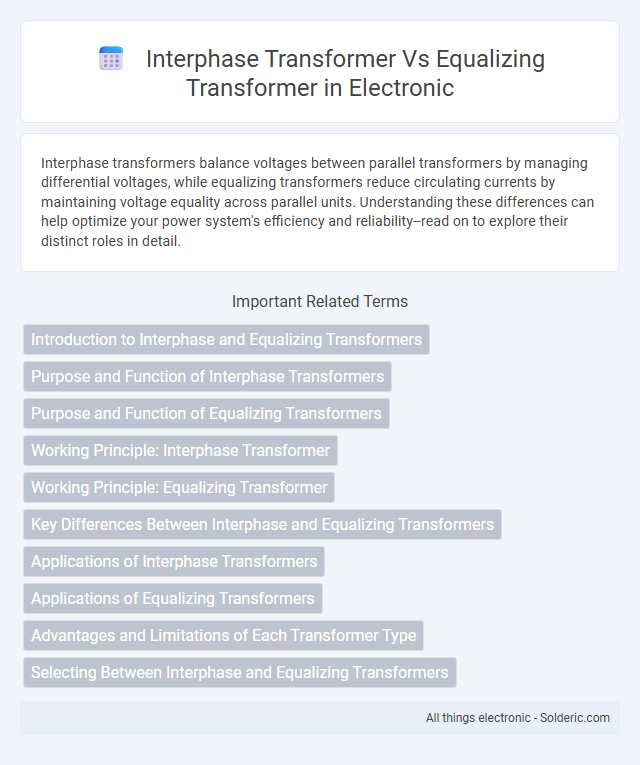Interphase transformers balance voltages between parallel transformers by managing differential voltages, while equalizing transformers reduce circulating currents by maintaining voltage equality across parallel units. Understanding these differences can help optimize your power system's efficiency and reliability--read on to explore their distinct roles in detail.
Comparison Table
| Feature | Interphase Transformer | Equalizing Transformer |
|---|---|---|
| Primary Function | Balances voltages between parallel generators or transformers | Equalizes circulating currents and voltages in parallel generator buses |
| Typical Application | Used mainly in multi-phase systems to maintain phase voltage balance | Used in parallel generator operation to prevent circulating currents |
| Connection Type | Connected between phases of different generators or transformers | Connected between neutral points of parallel machines or buses |
| Voltage Regulation | Improves voltage regulation by reducing phase-to-phase voltage differences | Does not directly regulate voltage, focuses on current equalization |
| Circulating Currents | Helps reduce circulating currents due to voltage unbalance | Specifically designed to eliminate circulating currents in parallel sets |
| Typical Rating | Lower power rating compared to equalizing transformers | Higher power rating due to handling circulating currents |
| Construction | Simple transformer with multiple windings for phase connections | Robust design with heavy windings to handle circulating currents |
| Cost | Generally less expensive | More expensive due to enhanced construction and rating |
Introduction to Interphase and Equalizing Transformers
Interphase transformers are specialized devices used to minimize circulating currents and balance voltages between parallel transformers or generator phases, ensuring stable power distribution. Equalizing transformers serve to equalize the voltage potential between interconnected electrical machines, preventing circulating currents and reducing system losses. Both transformers play crucial roles in maintaining system stability and efficiency in power networks by managing voltage differences and current imbalances.
Purpose and Function of Interphase Transformers
Interphase transformers are designed to connect two different power sources or systems, enabling the transfer and balancing of load currents while maintaining voltage levels and phase angles between the interconnected networks. Their primary function is to minimize circulating currents and ensure stable operation by compensating for phase differences, which enhances system reliability and efficiency. Unlike equalizing transformers, which focus on eliminating cross-circulating currents in parallel feeders, interphase transformers serve as a crucial link for synchronizing and regulating power flow between separate circuits.
Purpose and Function of Equalizing Transformers
Equalizing transformers are designed to maintain voltage balance and reduce circulating currents in parallel power systems, ensuring stable load sharing between transformers. Your electrical network benefits from improved efficiency and protection against uneven load distribution, which can cause overheating or equipment damage. Unlike interphase transformers, equalizing transformers specifically address voltage imbalances in interconnected systems, enhancing overall system reliability.
Working Principle: Interphase Transformer
Interphase transformers operate by linking the outputs of parallel rectifiers to maintain voltage balance and reduce circulating currents, ensuring stable operation in multi-phase power systems. The transformer's magnetic coupling allows it to equalize voltage differences between phases, improving overall system reliability and efficiency. Your power network benefits from this principle by preventing distortion and achieving synchronized voltage levels across interconnected phases.
Working Principle: Equalizing Transformer
The working principle of an equalizing transformer involves balancing voltage variations between series-connected battery cells by allowing current flow to equalize charge levels. It operates by linking cells electrically to transfer energy from higher-voltage cells to lower-voltage ones, preventing overcharging and undercharging. Your battery system's efficiency and lifespan improve significantly through this controlled voltage equalization process.
Key Differences Between Interphase and Equalizing Transformers
Interphase transformers are designed to connect separate power sources in parallel, ensuring voltage balance and phase alignment between systems, while equalizing transformers specifically mitigate circulating currents by balancing voltage differences across parallel feeders. The primary function of interphase transformers is to facilitate the parallel operation of generators or transformers with different voltage or frequency characteristics, whereas equalizing transformers focus on maintaining stability and load sharing in interconnected distribution networks. Understanding these distinctions helps optimize your power system's efficiency and reliability in complex electrical installations.
Applications of Interphase Transformers
Interphase transformers are primarily used in power systems to improve voltage regulation and reduce harmonic distortion by balancing loads across parallel transformers. They enable load sharing between transformers operating in parallel, ensuring stable voltage distribution and enhancing system reliability. Common applications include power plants, substations, and industrial facilities where synchronized operation of multiple transformers is critical.
Applications of Equalizing Transformers
Equalizing transformers are primarily used in power systems to balance voltage differences between interconnected transformers, ensuring smooth load sharing and reducing circulating currents. They find applications in parallel operation of transformers, rectifier circuits, and synchronous machinery where voltage imbalance can cause efficiency losses or equipment damage. These transformers help maintain system stability and improve power quality by equalizing phase voltages across interconnected networks.
Advantages and Limitations of Each Transformer Type
Interphase transformers provide reliable voltage regulation and isolation between phases, reducing circulating currents in parallel power systems, but their complexity and cost can limit widespread use. Equalizing transformers help maintain balanced voltages and share load currents in parallel generators, enhancing system stability; however, they may introduce additional losses and require careful design to avoid resonance issues. Both transformer types improve power quality in multi-generator setups but must be selected based on specific application needs and system configurations.
Selecting Between Interphase and Equalizing Transformers
Selecting between interphase and equalizing transformers depends on your load balancing and fault tolerance needs. Interphase transformers are ideal for reducing circulating currents and enhancing stability between paralleled transformers. Equalizing transformers are better suited for equalizing voltages across transformers to maintain system reliability under varying load conditions.
interphase transformer vs equalizing transformer Infographic

 solderic.com
solderic.com